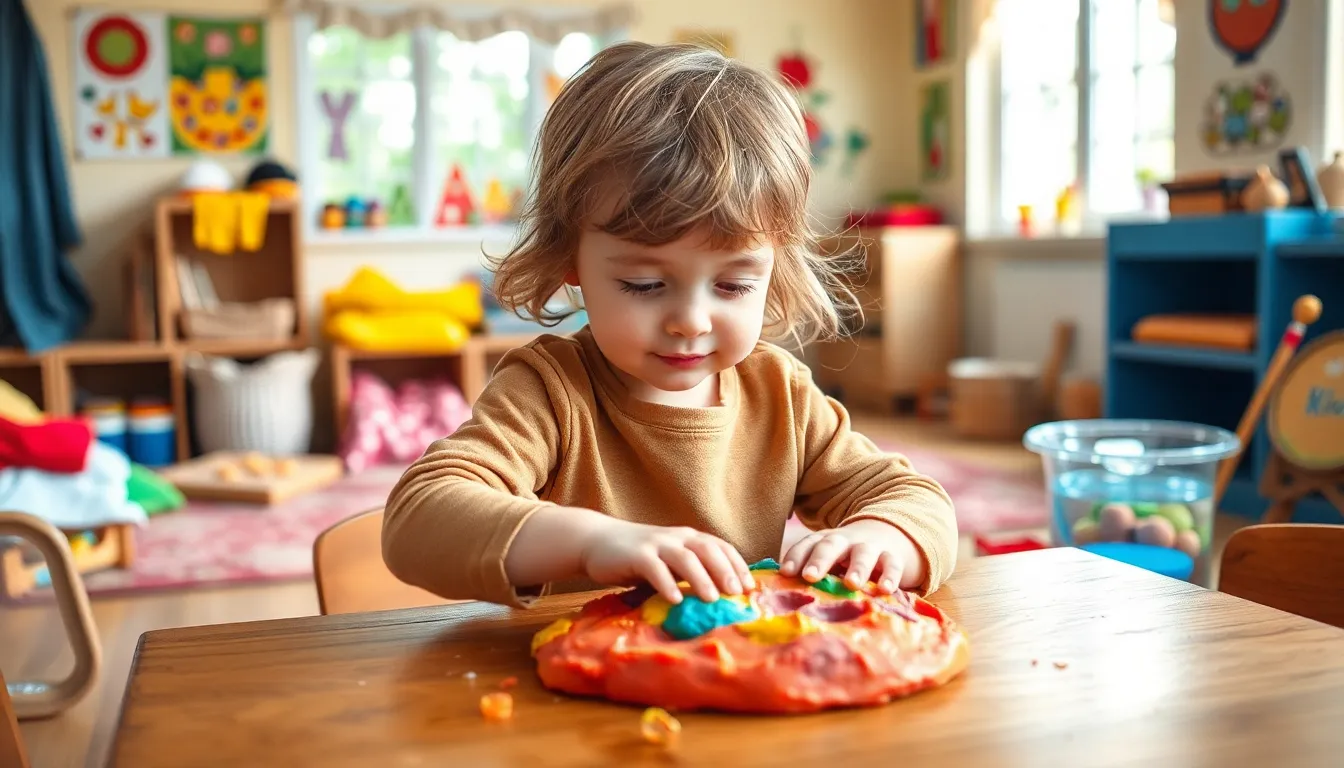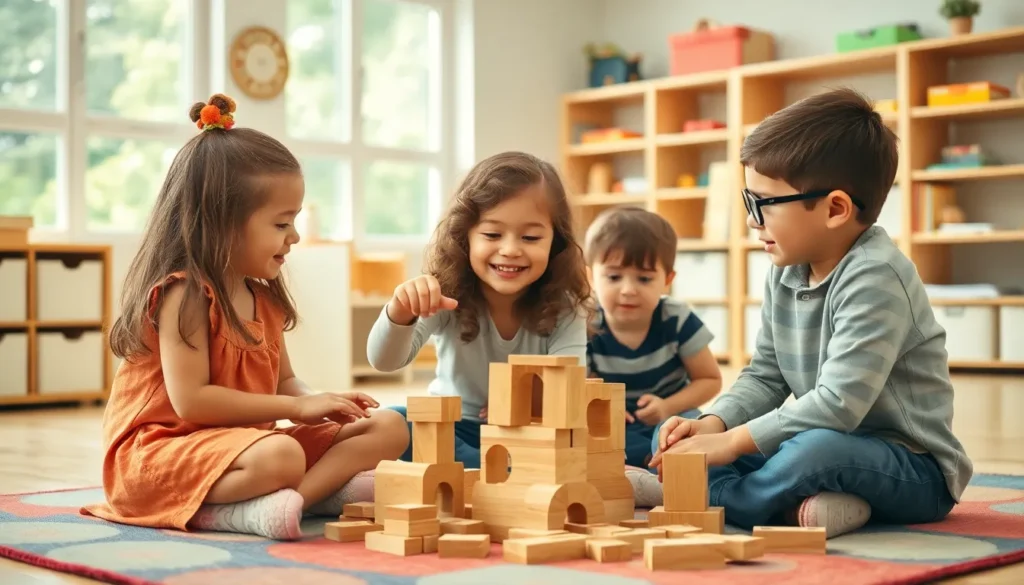Table of Contents
ToggleIn a world where screens dominate playtime, sensory play is like a breath of fresh air—or maybe a splash of paint on a white wall. It’s not just about making a mess; it’s about unlocking a treasure trove of learning opportunities. From squishy slime to crunchy rice, sensory play engages kids’ senses, sparking creativity and curiosity in ways that traditional toys can’t.
What Is Sensory Play?
Sensory play involves hands-on experiences that stimulate a child’s senses. Activities like playing with sand, water, or textured materials engage kids while promoting exploration.
Definition and Importance
Sensory play refers to any activity that encourages children to use their senses. Engaging multiple senses fosters cognitive growth, enhances fine motor skills, and supports emotional development. Children actively discover the world around them through different textures, sounds, and smells. Utilizing sensory play in a child’s routine fuels curiosity and creativity, providing enriching learning experiences. In a world increasingly dominated by screens, sensory play emerges as a vital approach to holistic childhood development.
Benefits for Child Development
Sensory play offers numerous developmental benefits for children. It promotes language skills as kids learn to describe their sensory experiences. Engaging in sensory experiences enhances problem-solving abilities, encouraging children to explore and manipulate different materials. Social interaction occurs through cooperative sensory play, allowing kids to communicate and work together. Additionally, it helps in emotional regulation, providing an outlet for stress relief. Overall, incorporating sensory play into each child’s everyday activities supports their physical, social, and emotional growth.
Types of Sensory Play

Sensory play encompasses various activities that stimulate children’s senses. These play types engage kids and promote cognitive and emotional development.
Tactile Activities
Tactile activities focus on the sense of touch. Examples include playing with textured materials like sand, playdough, or slime. Children explore varying textures, which enhances their fine motor skills. Activities involving water, rice, or beans also fall under tactile experiences. Engaging multiple senses encourages curiosity and creativity. Tactile play fosters a hands-on learning environment, allowing kids to experiment and discover. For instance, creating shapes with playdough promotes both creativity and dexterity.
Visual and Auditory Experiences
Visual and auditory experiences enrich sensory play. Bright colors, engaging patterns, and contrasting objects captivate children’s attention. Activities like painting or using colored light filters stimulate visual senses. Sound-based activities, such as musical instruments or sound jars, promote auditory exploration. Kids develop listening skills and learn to differentiate between sounds. Combining these experiences creates a holistic approach to sensory development. Participating in interactive storytelling can also enhance both visual and auditory engagement.
Olfactory and Gustatory Exploration
Olfactory and gustatory exploration focuses on smell and taste. Activities involving scents such as herbs, spices, and scented playdough tap into children’s sense of smell. Exploring different flavors through cooking or tasting games engages their taste buds. These experiences encourage children to express preferences while learning about nutrition. Baking or making smoothies provides a fun way to combine these senses. Parents can create scent boxes with various materials to enhance olfactory stimulation. By discovering aromas and flavors, children gain a broader sensory understanding of their environment.
How to Set Up Sensory Play Activities
Creating sensory play activities involves selecting the right materials and ensuring a safe environment for children. These steps enhance learning and exploration during sensory experiences.
Choosing the Right Materials
Selecting materials for sensory play requires thoughtfulness. Use items that stimulate various senses, including rice, sand, and water beads. Incorporating textured materials like playdough or fabric engages children’s tactile senses. Non-toxic materials remain essential, especially for younger kids who may explore through taste. Natural elements like leaves or rocks provide unique sensory experiences while promoting ecological awareness. Always consider children’s preferences and developmental stages, ensuring activities remain engaging.
Creating a Safe Environment
Establishing a safe environment for sensory play helps prevent accidents. Designate a play area that is free from hazards and provides ample space for movement. Utilize tablecloths or trays to contain materials, reducing mess and enabling easy cleanup. All materials should undergo thorough inspection for choking hazards. Proper supervision allows educators or caregivers to guide activities and respond to safety concerns. Clear boundaries encourage children to explore while protecting both them and their surroundings.
Popular Sensory Play Ideas
Numerous engaging sensory play ideas stimulate children’s development while keeping them entertained.
DIY Sensory Bins
Creating DIY sensory bins provides a versatile way to engage a child’s senses. Materials can include rice, beans, or pasta, each offering unique textures and colors. Sand or water can also be great additions for more exploration. Tactile tools like scoops, cups, and spoons enhance fine motor development while children sift, pour, and mold. These bins can be themed around seasons, holidays, or different cultures to expand learning experiences. Regularly rotating materials keeps the activity fresh and exciting.
Outdoor Sensory Activities
Engaging in outdoor sensory activities allows children to explore nature while enhancing sensory experiences. Activities such as digging in the dirt, collecting leaves, or observing insects promote curiosity. Water play with buckets or sprinklers introduces splashing sensations and opportunities for imaginative play. Creating a nature scavenger hunt encourages exploration and teaches children about their environment. Consider adding fragrant plants such as mint or lavender to enrich olfactory experiences. Combining these activities not only boosts sensory skills but also reinforces physical development through active play.
Sensory play stands as a fundamental component of childhood development in today’s digital age. By engaging multiple senses through hands-on activities, children not only enhance their creativity but also build essential skills that traditional play may overlook. The diverse experiences offered by sensory play foster cognitive growth and emotional well-being, making it a critical part of learning.
Incorporating sensory activities into daily routines can create a rich environment for exploration and discovery. Parents and caregivers can easily set up engaging sensory experiences that keep children curious and active. Embracing sensory play can lead to a more balanced and enriching childhood, laying the groundwork for lifelong learning and development.







